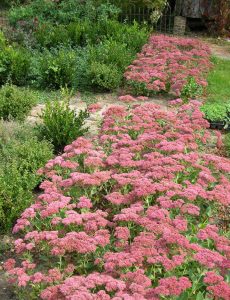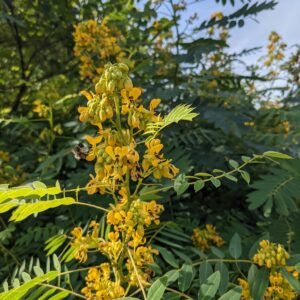Plants for Butterflies and Other Pollinators
Showing 177–184 of 223 results
-
Scrophularia macrantha syn. Scrophularia coccinea Redbirds in a Tree, Mimbres figwort Z 5-10
This sub-shrub blooms from early summer until frost with white-lipped cherry-red, tubular flowers that look like a flock of inch-long, baby birds with open mouths waiting for food, each topping short stems along the branches. The margins of its oval green leaves are toothed.
OUT OF STOCK – EMAIL FOR AVAILABILITY
This sub-shrub blooms from early summer until frost with white-lipped cherry-red, tubular flowers that look like a flock of inch-long, baby birds with open mouths waiting for food, each topping short stems along the branches. The margins of its oval green leaves are toothed.
Size: 2-4’ x 18”
Care: sun to part shade in well-drained to moist well-drained soil. Little to no fertilizer.
Native: Three mountain tops in southern New Mexico (high elevations make it hardy to cold regions)
Wildlife Value: Its nectar is one of the best feeders and attractors for hummingbirds. Pollen and nectar also attract butterflies and bees.
Awards: 2008 Plant Select WinnerFirst collected on the Mexican Boundary Expedition by Charles Wright (1811-1885) and John Bigelow (1804-1878), “at the base of a rocky ledge near the summit of a mountain . . .a truly handsome species.” Described by Asa Gray, Torrey, John ed. Report on the United States and Mexican boundary survey Vol. 2 p. 111 (1859)
-
Scutellaria altissima Somerset skullcap Z 4-10
In early summer masses of upright stems bearing bi-colored, bluish-purple and white, snapdragon-like flowers, the hood being bluish-purple and the lower lip white. Flowers grow on one side of the spike. This will re-bloom if you cut the flowers.
In early summer masses of upright stems bearing bi-colored, bluish-purple and white, snapdragon-like flowers, the hood being bluish-purple and the lower lip white. Flowers grow on one side of the spike. This will re-bloom if you cut the flowers.
Size: 24-36” x 18-24”
Care: sun to part shade in moist well-drained to well-drained soil
Native: central & eastern Europe
Wildlife Value: pollen and nectar attracts bees and butterflies1st described and named in 1700 by Joseph Pitton Tournefort, French botanist.
-
Scutellaria baicalensis Chinese skullcap Z 4-8
Spikes of purplish-blue trumpets all summer into fall
OUT OF STOCK
Spikes of purplish-blue trumpets all summer into fall
Size: 12” x 12”
Care: sun in moist well-drained soil
Native: eastern Asia, SiberiaLinnaeus’ imaginative mind named this genus after the Latin sculellum meaning “a little dish,” because of its resemblance to the flower’s helmet-shaped calyx. In its native China called huang-chin. Used medicinally since ancient times in China to cure colds, fever, headaches and insomnia. William Robinson, father of the mixed perennial border, described the flowers and use of skullcap as having “rich velvety dark blue flowers.”
-
Scutellaria incana syn. Scutellaria canescens, Scutellaria villosa Downy skullcap Z 5-8
Showy, open spikes of two-lipped Blue-violet florets from June-Sept
Flowers of spikes of purple-blue tubes ending in two open lips, the lower lip having a white blotch, blooming for months from July to September, if deadheaded
Size: 2-3’ x 12-18"
Care: sun to part shade in moist well-drained to well-drained soil. Reblooms if deadhead after 1st flush of flowers
Native: NY to WI, Georgia to TX, Wisconsin native
Wildlife Value: Deer resistant. Its nectar feeds small butterflies, Bumblebees and Hummingbirds.The name Scutellaria is from Latin scutella meaning a small dish or saucer referring to the shape of the persistent calyx, a covering at the flower’s base. Incana means grey referring to the tiny hairs on stems and undersides of leaves giving a greyish color. Named by Johann Friedrich Theodor Biehler, German botanist from the plant specimens in Christian Sprengel’s (1750-1816) herbarium in 1807. How did German botanist Sprengel, who never set foot in America, come to have a pressed specimen of this native American plant? Sprengel and German botanist Carl Ludwig Willdenow (1765-1812) were close collaborators. Another German botanist Heinrich Ernst Muhlenberg (1753-1815), living in Lancaster Pennsylvania, sent many American plants specimens to Willedenow. Scutellaria incana is native to and grows in what is now called Muhlenberg Meadow in Lancaster County PA. These connections make it likely that the specimen Biehler saw came from Henry Muhlenberg.
-
Scutellaria resinosa syn. Scutellaria wrightii Prairie skullcap Z 4-9
Two-lipped, deep violet-blue tubes bloom from spring to fall
Two-lipped, deep violet-blue tubes bloom from spring to fall
Size: 10” x 10”
Care: sun to part shade in well-drained to moist well-drained soil, drought tolerant
Native: Colorado, NM, KS, Oklahoma, TX, collected on the Canadian River, tributary of Arkansas River
Wildlife Value: deer & rabbit resistant. Nectar and pollen attract butterflies and bees.Described by botanist John Torrey in Annals of the Lyceum of Natural History of NY 2: 232 (1828)
-
Sedum ‘Autumn Joy’ syn ‘Herbstfreude’ syn Hylotelephium ‘Autumn Joy’ Z 4-9
Classic, large flat flower heads turn from green to rose
Classic, large flat flower heads turn from green to rose blooming in September and October. A staple for autumn in the garden.
Size: 30” x 12”
Care: full sun in well-drained soil
Awards: England’s Royal Horticultural Society Award of Garden Merit.Sedum means “plant that sits.” “Live forever” is an ancient Greek name for sedums. The Roman Pliny claimed that sedum’s juice treated wounds. In the 1500’s English herbalist Gerard called sedums “very full of life,” referring to succulent’s quality of being very easy to grow. Autumn Joy introduced to gardens before 1920 by the George Arends Nursery in Ronsdorf, Germany.
-
Senna hebecarpa syn. Cassia hebecarpa Wild senna Z 4-8
6” long taxicab yellow racemes in July – August
6 inch long taxicab yellow racemes in July – August
Size: 4’ x 2-6’
Care: full sun in moist well-drained soil
Native: all North America east of Mississippi River from Hudson Bay south to Georgia and Tennessee, Wisconsin native
Wildlife Value: attracts bees, butterflies, birds & hummingbirdsCollected by 1753. Very similar to Senna marilandica except a bit taller, flowers prettier and a slightly bulbous gland as the base of the petiole.
-
Seseli gummiferum Moon carrot Z 5-9 self-seeding biennial or short-lived perennial.
Five-inch diameter mound of many circles of pale pink to white flowers atop silvery, frilly, fern-like foliage flowering in mid-summer into early fall.
Five-inch diameter mound of many circles of pale pink to white flowers atop silvery, frilly, fern-like foliage flowering in mid-summer into early fall.
Size: 2-3’ x 12-18”
Care: Sun to part-shade in well-drained to moist well-drained soil
Native: Crimea, Turkey and South Aegean
Wildlife Value: Deer resistant. Butterfly magnet; host for caterpillar of Eastern swallowtail butterfly.Seseli is an ancient Greek name of an umbelliferous plant. This species first described by Linnaeus in 1735. In Re classified and renamed in 1830 in Prodromus systematis naturalis regni vegetabilis, sive, Enumeratio contracta ordinum generum specierumque plantarum huc usque cognitarium, juxta methodi naturalis, normas digesta.





